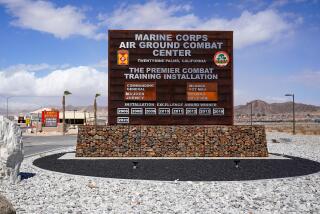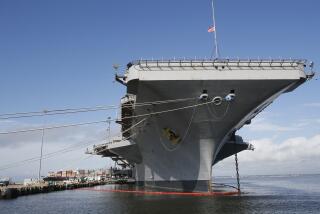Uncertain Tour of Duty : Navy Chief Praises Seal Beach Station, Sidesteps Future
- Share via
SEAL BEACH — Navy Secretary John H. Dalton had nothing but praise for the Seal Beach Naval Weapons Station during a 50th anniversary celebration at the base Wednesday, but he was noncommittal about its future in comments after the ceremony.
Speaking under cloudy skies to an audience of 300 community leaders, veterans and base employees, Dalton called the military facility “the most cost-effective weapons station in the Navy.”
But when the secretary appears this morning at a Base Realignment and Closure conference in Long Beach, he will not advocate either closing the base or keeping it open. All military installations are under review by Defense Department officials, who are expected to recommend cutbacks to a federal base closure commission in March.
“We’re evaluating each facility, and we’ll make recommendations to the secretary of defense shortly after the first of the year,” Dalton said at a news conference after the ceremony. “We still have a lot more work to do before we make those decisions.”
The anniversary celebration marked Dalton’s first visit to the Naval Weapons Station, where about 700 civilian employees are nervously awaiting the elimination of 100 more jobs by mid-November. There has been a 50% cut in the civilian work force during the past six months. There are no immediate cuts planned for the 175 military personnel on duty, according to base officials. But in the post-Cold War world, military downsizing is a way of life, Dalton said.
“It’s the right thing to do for us to get smaller, but it’s important that we do it in the right way,” Dalton said. “In order for us to be able to afford the new ships and the new aircraft--plus take care of our people . . . we have to reduce infrastructure.”
Seal Beach residents fear rampant development on the 5,000-acre base if the weapons station is closed as the federal government reduces the size of the military. And environmentalists worry about the future of the 1,000-acre Seal Beach National Wildlife Refuge on base grounds.
After Seal Beach Mayor George Brown presented base commander Joel F. Steadley with a congratulatory proclamation, he told the audience that in 50 years, he hoped the mayor of Seal Beach would be celebrating the centennial of the weapons base.
After the bombing of Pearl Harbor in 1941, Seal Beach was one of four West Coast sites selected by the Navy for ammunition depots. But the opening of the Seal Beach station was delayed by the difficulty of securing land from myriad private owners, according to Capt. John C. Devlin, commander of the Pacific Division Naval Ordnance Center, which is headquartered here.
“Here at Seal Beach, there were more than 1,000 landowners to work with, to acquire the property rights for the federal government,” Devlin said during the ceremony. “Even though America had suddenly been pushed into the second World War, the Navy exercised due caution in protecting the rights of the Seal Beach landowners.”
The weapons base opened Nov. 2, 1944, as the Seal Beach Naval Ammunition and Net Depot, charged with the primary mission of storing ammunition and repairing steel anti-submarine nets used to block enemy submarines from entering American ports.
In the 1950s, the base adapted to missile maintenance duties, becoming a full-fledged weapons station in the 1960s. During that period, part of the Saturn 5 rocket system used in the Apollo and Skylab space missions was assembled at the weapons station.
During his speech, Dalton pointed out the critical role the weapons station now plays in supplying most of the Navy’s surface-to-air missiles to the Pacific Fleet, which is based in San Diego.
“Likewise, it is here that the Tomahawk missile--potent weapon of the Gulf War and deterrent for such future wars--is readied for the fleet,” he said.
Dalton, 52, served on two submarines during a stint in the Navy from 1964 to 1969. He was nominated to the Federal Home Loan Bank board by President Jimmy Carter in 1979 after a career in investment banking. He became the 70th secretary of the Navy in July, 1993.
More to Read
Sign up for Essential California
The most important California stories and recommendations in your inbox every morning.
You may occasionally receive promotional content from the Los Angeles Times.













